| News |
| 46 - 60 of 80 « previous next » |
|
Greenfoot Kinect software updated

The Kinect software for working with Greenfoot and the Kinect has been updated. The new version is faster, better (it tracks user outlines properly) and now copes properly with the sensor going to sleep. We’ve just released version 1.1 of the Kinect software for Greenfoot. You can install the new version on Windows just by downloading the new executable, or on Ubuntu by downloading the source and rebuilding. We hope to provide a proper Mac OS X release in the next week or two. If you’ve already started a Greenfoot Kinect scenario with version 1.0, follow the instructions at the end of the examples page to update your Greenfoot scenario with the latest client software. This new software has several changes in it. One is that user outlines are properly tracked. Previously, due to a bug, the user’s outline was not accurate where there were gaps in the image (e.g. between the arms and body, or between the legs), but this has now been fixed. The software used to not be able to properly restart the sensor if it went to sleep after a long period (hours) of being idle, but this has also been fixed. Additionally, the software has been optimised which should help it to run better on slower CPUs. |
|
Program With Greenfoot and Kinect
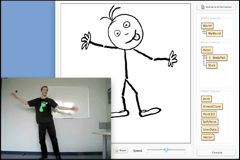
The library to program Greenfoot scenarios with the Kinect module is now available. Watch a short video here, and find out the details. The Microsoft Kinect is a sensor module, including depth-sensing cameras, that can track movements of people in a room. It was originally developed by Microsoft for the Xbox 360 games console, but it can also be connected to a standard PC or laptop via a USB connection. Writing programs yourself with the Kinect is incredibly good fun. Games and other scenarios can be written that are controlled by users running, jumping or simply moving their arms around. If you are looking to get students excited (or, to be honest: get excited about programming yourself), using the Kinect as a motivator is a very promising approach. By combining a physical element to the program running on screen, computing acquires a new dimension which can often get kids engaged that otherwise don’t relate to programming. To get an idea of the potential, you may like to watch the following short video. </param></param></param></embed>We have now released the libraries and documentation needed to program the Kinect with Greenfoot. All software and documentation is available here. If you do experiment with this (or even use it in a classroom) please report back to us. Experience reports would be very welcome! |
|
Greenfoot workshop at CCSCNE 2011

An introductory Greenfoot workshop will be offered on 15 April 2011 at the CCSCNE 2011 Conference, held at the Western New England College, Springfield, MA, USA. The conference is held annually by the Consortium for Computing Sciences in Colleges and offers a two day programme for computing teachers. The Greenfoot workshop will be led by the Greenfoot Hub leaders of the New York and New Jersey hubs, Adrienne Decker & Fran Trees. You can find more detailed information on the Greenfoot Hub web page. Feel free to contact Adrienne or Fran if you have questions. |
|
Greenfoot News now available via RSS

The Greenfoot News announcements are now also available via RSS. Those of you who like to get their news delivered straight to your inbox, either in your mail client or any other favourite RSS reader, can now do so by subscribing to the Greenfoot News RSS feed. The feed address is here: http://greenroom.greenfoot.org/news/rss If you are an RSS user, then sign up and stay up to date with what’s going on with Greenfoot. |
|
One Year of the Greenroom

The Greenroom turns one. In late March 2010, the Greenroom was officially opened to the public. A year on, we have more than 100 resources and over 1,000 members. Let’s all raise a glass and have a drink in celebration. It has been going incredibly well so far, with many people joining in, interesting discussions and many useful resources submitted. We, the Greenfoot Team, would like to thank everyone who has helped making this a lively place, by asking questions, offering advice, contributing to resources, etc. Please keep it up. To a successful second year! |
|
Connect with Kinect

The Microsoft Kinect™ module, a body tracking sensor developed originally for the Xbox game console, is fast becoming one of the most popular gaming devices. Now it’s become easy to program—with Greenfoot. The Kinect module can be easily connected to any PC or laptop with a standard USB connector. The Greenfoot team has recently worked on connecting the Kinect to Greenfoot. The result is a Greenfoot library that makes it incredibly easy to write Greenfoot scenarios that use the Kinect sensor input. Scenarios can include anything from games that react to the users movements in the room (such as jumping, reaching, running) to artistic projects. The library can track multiple users at the same time. The potential is endless. The Kinect hardware includes a camera, and the Greenfoot/Kinect library gives easy access within Greenfoot scenarios to the location (that is: x,y coordinates) of the joints of bodies within the view of the module. Head, shoulders, elbows, hips, knees and feet are all tracked and can easily be monitored.
The libraries will be released publicly by mid April. Until then, you can see a brief demo video to get an impression what it may look like. In this short video, Neil Brown, developer of the Greenfoot/Kinect library, shows how to paint by doing nothing more than waiving your hands in the air. |
|
Greenfoot at SIGCSE
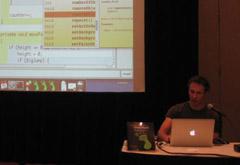
Several Greenfoot events took place last week at the SIGCSE 2011 conference in Dallas, Texas, including a popular Greenfoot Breakfast with information and demos of new Greenfoot developments. The Greenfoot Breakfast Club, as the early Saturday morning event was titled, required dedication to attend: a starting time of 7:00 am meant it was not aimed at night owls and late risers. However, a large crowd braved the early morning starting time and attended an hour full of information about recent Greenfoot developments and demos of a variety of Greenfoot technologies. Ian Utting gave an introduction to the Greenfoot system, followed by a run through a variety of features newly added to the Greenfoot environment over the last year. These included the new editor features introduced in Greenfoot 2.0, such as code completion and syntax highlighting. These were demonstrated by Davin McCall, the leading developer on the new editor implementation project. Among the most popular new additions to Greenfoot was announcement of support for a variety of hardware devices. These include support for Pico boards, Gamepads, the Finch robot and the Microsoft Kinect. Pico boards are inexpensive sensor boards developed at MIT for use with the Scratch environment. They contain a number of sensors which can now be accessed easily from Greenfoot through a custom built library. A demo scenario to get started with Pico boards is available now.
Gamepads, controllers for popular games consoles such as the Nintendo Playstation and the Microsoft Xbox, are especially attractive to use because they are ubiquitous and cheap. Many students will have a controller at home, which can also be plugged in to a PC or laptop via a USB connector. Several demo scenarios and a project template are now available on the Greenfoot web site showing how to use a standard game controller to play Greenfoot games. Connecting robots to Greenfoot was shown with the Finch robot, a small affordable robot designed for use in computer science education. The Finch can be programmed to move around the room, detect light, temperature and obstacles, and even has an accelerometer. Greenfoot sample scenarios and project templates are available now.
Possibly most excitement at the breakfast event was created by the Kinect demo, presented by Neil Brown. The Kinect is a sensor device developed by Microsoft for the Xbox games console. It can track movements of a human body, allowing users to control their programs by moving their arms and legs, jumping, running, or any other physical movement. Neil demonstrated a simple Greenfoot scenario that lets user paint on the screen using nothing but waving their hands in the air. The Greenfoot Kinect library will be published shortly. The breakfast event concluded with an introduction of five of the Greenfoot Hubs leaders, who presented their current activities (schedule available here) and gave audience members a chance to talk to them afterwards.
Other Greenfoot events at SIGCSE included two workshops, one for Greenfoot beginners and a second one aimed at producing Greenfoot teaching material. |
|
Thomas Cooper, Leader Of The Atlanta Hub

Hub number 5 on our list of Greenfoot Hubs is Atlanta, with its Hub Leader Thomas Cooper, Computer Science Department Chair at the Walker School in Marietta, Georgia. Thomas teachers Introduction to computer science, in Python, and Games and Simulations, using Greenfoot and Java. In addition, he teaches Outdoor Culture and Technology (KML and Expedition History), an AP Computer Science class, and serves at the Technology Integration Coordinator for the school. Thomas is the faculty sponsor for the school’s VEX robotics team and the faculty sponsor for the Outdoor Adventure Club. He is also currently serving at the GaCSTA Vice-President. Having been involved with teaching programming for the past 2 years, this is Thomas’ first year teaching AP Computer Science. He encountered Greenfoot about 2 years ago when he was doing research for the school’s intermediate programming course. Thomas was first considering another system but changed his mind when he came across Greenfoot. Thomas said: “I realized that Greenfoot had the capability to actually program in Java rather than using a drag and drop game design engine. It is easy to use and has a high ceiling. It has really interested the students in becoming better programmers.” Another initiative Thomas is working on is an online collaborative programming project he is doing with APCS students from different schools in the SE region. He is using Google Tools, JavaWIDE and Elluminate to program fractals using recursion. The tools allow students to work together, record their programming sessions, and talk together in small groups for brainstorming and problem solving. Thomas enjoys camping, hiking, kayaking and caving. He has a Shepard/Lab mix named Ginger, who he takes with him on trips whenever he can. He is trying to visit a national park each year in his quest to visit all 54 parks in the US. |
|
Fran Trees, leader of the Greenfoot Hub New Jersey
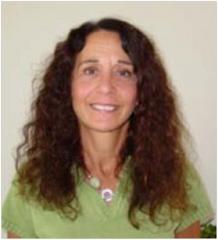
Today we introduce Fran Trees, from Drew University, leader of the New Jersey Greenfoot Hub. Fran has been teaching mathematics and computer science at Drew University in Madison, New Jersey, USA since 2001. She primarily teaches introductory programming courses and has integrated Greenfoot into these courses. Prior to Drew, she taught computer science and mathematics at the high school level. Her research interest, pedagogical tools used in introductory programming classes, was the impetus for playing with, and teaching with, Greenfoot. Fran is actively involved with the Advanced Placement Computer Science program and has conducted AP CS teacher workshops and institutes for many years. She is also Chapter Liaison for the Computer Science Teacher’s Association (CSTA), where she promotes CS education and professional development to various local CS communities. When not teaching programming, Fran teaches SCUBA diving and enjoys running, biking, swimming, and skiing. She lives in northern New Jersey with her best friend (and cohort in all of these activities) and their four cats and two tropical fish (one of which is 14 years old). Plans for the New Jersey Hub this year include after school workshops for local teachers and a workshop (in conjunction with the New York Hub) at the CCSC NE conference, April 15-16, in Springfield, MA. See the New Jersey Hub page for full details! |
|
Introducing Daniel Green, Leader of the Kansas City Hub
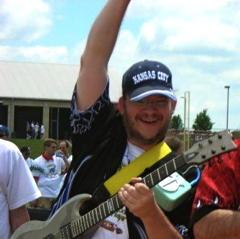
Next in our series of Greenfoot Hub Leaders is Daniel Green, leader of the Kansas City Hub. Daniel is a Java Systems Engineer with the Oracle Corporation, previously Sun Microsystems. Daniel has been part of the Java organization at Sun Microsystems and Oracle for thirteen years. He has been running computer club programs and workshops for six years, where students have opportunities to learn programming, make games and projects that emphasize computing as a tool for leveraging their creativity. Daniel works with students and teachers using tools such as Scratch, Alice, Greenfoot, Squeak, Dr. Java, Phun, OpenSim and others. Greenfoot and BlueJ have been particularly effective at transitioning from drag and drop environments like Scratch to similar game / scenario / simulation project environments using Java rather than a more complicated environment like NetBeans, Eclipse, or JDeveloper. Daniel first heard of Greenfoot from James Gosling during a conversation about computer science education, and it always seemed to be one of the coolest things at the ACM SIGCSE conference. When not teaching programming, Daniel is likely playing lead guitar in his band (which doesn’t involve a computer… yet…) or creating audio and video for theatrical performances for his local church (which involves more knobs, buttons and gizmos than most of the day job duties). Later this year, he plans to participate in the Immersive Education Initiative locally, extending programming into virtual worlds and augmented reality environments. |
|
Introducing the Greenfoot Hub Leaders: Stephanie Hoeppner, Ohio Hub

Continuing our series of presenting the Greenfoot Hub Leaders, we introduce Stephanie Hoeppner, leader of the Greenfoot Hub Ohio. Stephanie is a Computer Science Teacher as well an Assistant Technology Coordinator for Clermont Northeastern Schools in Batavia, Ohio, USA. She has been involved in teaching computer science courses for twelve years at the high school level. Stephanie is also a Cohort Leader for the Computer Science Teacher’s Association (CSTA), in which her role is promoting computer science education through training and advocacy. Her experience with Greenfoot complements these efforts. Stephanie first encountered Greenfoot in Spring 2007. She had been looking for a different way to teach Java in her programming courses and Greenfoot was the perfect solution. She uses Greenfoot in conjunction with Alice for an introductory programming course and Greenfoot as a part of a secondary level course. Using Greenfoot has made a dramatic difference in the understanding and interest of the students. Outside of work, Stephanie spends time with her husband, children, and two dogs. They love living in a small country town with four acres of space for their children to run around. Most of Stephanie’s free time though is devoted to her children’s activities. Plans for the Ohio Hub have included a past workshop in December, an upcoming workshop at the Ohio Education Technology Conference Feb 1st, and a workshop tentatively set for April. See the Ohio Hub page for full details! |
|
Greenroom hits 1000 members

Still six weeks shy of its first birthday, the Greenroom has just welcomed its 1000th member. Yes, we have just hit the big 1000. When we designed the Greenroom, we had no idea that it would be so popular, grow so quickly, and attract so much attention. Most surprising for us was that the rate of new people joining is not decreasing:
As the graph shows, the rate of people joining is quite steady. We had expected, that after a few months, all existing Greenfoot users would have found the Greenroom, and then the growth rate would slow, reflecting a much slower increase of new users. Many of the new members are indeed new Greenfoot adopters — it’s just that Greenfoot adoption has really taken off lately. Welcome to everyone who has joined recently! And the usual standard reminder: Don’t just sit back and read — get involved. Don’t wait for ‘them’ to do something. There is no ‘them’, there is only ‘us’. This is your community, and it is what you make of it. |
|
Introducing the Greenfoot Hub Leaders: Adrienne Decker, New York Hub
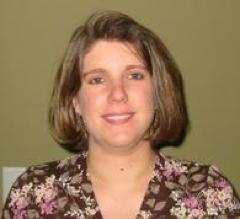
Making a start in our series introducing the Greenfoot Hub leaders is Adrienne Decker, leader of the Greenfoot Hub New York, located in Buffalo. Adrienne is a Teaching Associate Professor at the University at Buffalo, SUNY in Buffalo, New York, USA. She has been involved in teaching introductory programming since starting at UB in 2001. During her time at UB, Adrienne has helped to redesign the introductory sequence into an objects-first curriculum and integrate the teaching of UML, graphics programming, and Java to make a fun introductory sequence for the incoming computer science and computer engineering majors. Adrienne first encountered Greenfoot in Spring of 2008, while looking for a way to make programming fun and engaging for an introductory programming for non-majors course at UB. Since then, she has been hooked and has transformed that course into an introductory programming course that uses Greenfoot exclusively. She frequently hears comments from her students in this course about how fun it is to program using Greenfoot. When not teaching programming, Adrienne enjoys spending time with her husband, her 2 children (both of whom are under 4 years old), and her dog (a German Shepherd). Plans for the New York Hub this year include a workshop (in conjunction with the New Jersey Hub) at the CCSC NE conference (April 15-16 in Springfield, MA) and a summer workshop in Buffalo in July. Watch the New York Hub website for dates and details about the summer workshop. |
|
Greenfoot Hubs Now Open

Greenfoot is coming closer to your hometown. In an effort to bring Greenfoot support closer to our users, we have now started—in collaboration with a number of volunteers—to set up some Greenfoot Hubs in different places. These hubs will offer local workshops and training, support the community and help develop new material. Supporting the Greenfoot user community is something that we try to take seriously. We have put a large amount of effort into developing online support, be it via tutorials, videos, tech support mailing lists or the Greenroom. Online support is great - we can reach people that we otherwise would have no chance communicating with. However, online support is not the solution to everything. It has long been clear that the most effective and popular way of supporting teachers is via face-to-face workshops, training and discussions. This is the goal of the Greenfoot Hubs. Seven new Hubs have now been established, run by volunteers from a number of institutions. Five of these are in the United States (reflecting the fact that a very large part of our community is in North America), one in Germany (Berlin) and one in Moscow. Here’s the overview:
The US hubs are in Atlanta, GA, Madison, NJ, Buffalo, NY, Batavia, OH, and Kansas City, MO. Together with the Berlin and Moscow hubs and the pre-existing Greenfoot centres in Canterbury, Kent (UK) and Melbourne (Australia), this brings the total number of local hubs to nine. The Greenfoot Hubs will offer regular events for the Greenfoot community, both existing users and those new to Greenfoot. Several events are planned already — please have a look at the Greenfoot Hubs web page and see what is currently scheduled. If you are interested, and one of the events is local enough for you to get to – sign up now! If not, talk to the Hub leaders. Sometimes Hub Leaders are able to arrange workshops away from their home institutions. We hope to see many of you in one of our workshops over the next year! More information: Greenfoot Hubs web page |
|
End of Year Reflections

As we quickly approach the end of the year by many people’s calendars, this seems like as good a time as any for some reflections, a look back, a look forward and a few thank yous. On 1st March 2010, we officially opened the Greenroom. And it has been fascinating to watch ever since. We had been talking about the idea for such a site for quite some time before then. I had thought for a long time that it would be great to have a place where we could have a community of peers supporting each other, sharing, helping, working together, trying to make all our work easier and the lives of the kids we teach a bit better. I am a programmer, and I am used to work with technology. But at the end, it’s not about the technology, it’s about people. This — the building of the Greenroom — is the most directly social project I’ve worked on so far, and it was a bit scary at times. The main worry was that it wouldn’t work. I don’t mean that in the technical sense. We have excellent developers working on our team and I’ve always had faith in their ability to build the technology. I mean as a social experiment. “If you build it, they will come”, they say. I don’t think it’s true. All too often, you build it, and nobody bothers showing up. Then you and your mate Bob sit there staring at each other in silence, and cold wind blows through empty corridors. It isn’t quite that easy. There are many, many repositories of teaching resources that have tried and failed. People have said, only slightly facetiously, that there seem to be more repositories than teaching resources. The fact is that many projects, having built a repository, have struggled to keep it alive after the initial setup phase. How do you get people to spend their time posting resources? It is work! And for what reward? Each of those repositories lives in a self-reinforcing cycle: If people don’t post stuff, then the repository is not interesting. If it’s not interesting, no one looks at it. And if nobody looks, people don’t bother posting. How do you set the cycle onto a positive path? Clay Shirky, who probably knows more about this than most, when writing about social online communities summed it up like this: What is required to make a large, long-lived online group successful? — I can now answer with some confidence: It depends. So when we opened the Greenroom, we were very anxious to see whether people would sign up, and how they would interact with the site, and with each other. Before this Greenroom, there was a temporary one, a stop-gap measure while we were working on this implementation. It was a kind of “Greenroom 0.5” — the Greenroom run as a Google discussion group. This Google group existed for about six months, from September 2009 to March 2010. In that time, about 170 people signed up. Just about nobody posted resources. When we opened this new Greenroom and closed the Google group, only about half of them moved over. The other half disappeared. That, I thought, was not a good start. But then the numbers started climbing, and very quickly looked quite amazing. Here are the numbers of people signed up to the Greenroom, old (red) and new (orange):
After just a couple of weeks, we exceeded the original number of 170, and then subscriptions just kept climbing! To this day, I have no idea where everyone was suddenly coming from. There was obviously some word-of-mouth going on somewhere, but I don’t know where or how or why. And what’s more: People (that’s you!) were not only signing up, they were also posting resources. After a very short time we had a good dozen resources in the room. That was about the threshold that I thought we must reach to make it worthwhile for teachers to come here and have a look, and not feel that they wasted their time. It became clear quite quickly that something here on this site was working. It was still a self-reinforcing cycle, but a positive one: You signed up in good numbers, posted resources, asked questions, participated in discussions, etc. The site became interesting, and more people kept coming. We, the Greenfoot team, relaxed a bit and watched in amazement. The Greenfoot team are Davin, Marion, Neil, Phil, Ian and Michael. The Greenroom implementation was built mostly by Neil and Phil. We, from the Greenroom team, would like to thank all of you for making this site what it is: An active community. We very much realise that we can build the technology, the shell that keeps this up, but only you can fill it with life and give it content, make it worth coming back for. This was scary for us at first, because it’s out of our control. At some stage all you can do is sit back and hope. We still don’t know for certain what has made this site work where others before have withered away. But something has. So, we would like to encourage you to keep this up. Keep asking questions in the discussion section (or start asking, if you haven’t in the past), post your resources, even if you think they aren’t great or aren’t finished, help improving what’s there, and continue this open, supportive conversation with your peers. Happy New Year, Everyone! |
| 46 - 60 of 80 « previous next » |
Created by
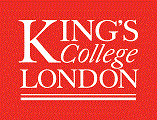 Supported by
Supported by
Copyright King's College London, 2017. Contact us.
 A standard gamepad
A standard gamepad Neil Brown, presenting at the Greenfoot Breakfast
Neil Brown, presenting at the Greenfoot Breakfast Greenfoot Hub Leaders
Greenfoot Hub Leaders

